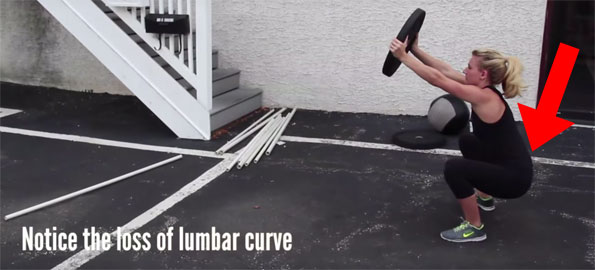
An example of the loss of lumbar curve at the low end of a squat.
Neutral Lumbar Spine and Loss of Lumbar Curve
When a person leans forward, there is a normal combination of motion of flexion of the spinal column and anterior pelvic tilt of the pelvis. Abnormally while squatting down, a person can hold the pelvis in a posterior pelvic tilt, and the result is that almost all of the forward lean is caused by flexion of the spinal column — especially at the lumbar region.
If a person leans forward entirely with an anterior or forward tilt of the pelvis, the lumbar curve will remain neutral, and there will be no flexion in the spinal column. Usually there is some point on the way down, where a person cannot hold the anterior pelvic tilt. Somewhere toward the bottom of the squat, the person will slip into a posterior pelvic tilt. The posterior pelvic tilt at the bottom of a squat should be avoided.
During a squat, dynamic anterior pelvic tilting is good on the way down; and dynamic posterior pelvic tilting is good on the way up.
When a person goes into deep knee flexion, there is a point where the person may lose control of the pelvic tilt — low ability to keep the pelvis in an anteior tilt. An anterior pelvic is the safest position for most people in a deep squat or deep crouch. The anterior pelvic tilt keeps the spinal column neutral — especially in the lumbar region. The anterior tilt also keeps the hip extensors pre-stretched for contribution of force production for coming out of crouched position with power for hip extension and dynamic posterior pelvic tilting.
If a person squats down with a forward lean of the torso and goes into a posterior pelvic tilt while bottoming out (actually bottoming “in”), the person will lose hip extensor power and lose major force control of the torso and pelvis from the hip extensor muscles because the hip extensor muscles become slack between attachment to the pelvis (ischial tuberosity) and the attachment near the knee joint. The full posterior tilt of the pelvis at the bottom of a squat causes flexion in the lumbar region and causes potentially harmful compression of the intervertebral discs between the vertebral bodies along the spinal column.
The knees are also potentially harmed by a full down weight-bearing squat. When the end range posterior pelvic tilt occurs in a deep squat or crouch, and the power is lost from the slacked hip extensors (or hamstrings), the force to lift the body upward must come from the quadriceps (knee extension) and the low back muscles (torso extension) — compensating for the lack of force output from the hip extensors for hip extension. The force output of the quadriceps is transmitted through the knee and especially to the patella and the patellar tendon (ligament), causing unnecessary stress on the knees.
The deep squat puts a great deal of force transmission from the ground to the feet, lower legs, across the knees, and to the force output of the quadriceps. The knee as a fulcrum takes a beating internally on the meniscus, and on the anterior and posterior cruciate ligaments. Compared to standing, consider the force level that is increased on the knees when the thigh or femur is 90-degrees to the tibia and fibula. Consider also the energy that is wasted, for example, when a golfer crouches and maintains a static position while inspecting the hole before a putt.
More coming soon.
Denise Thomas corrects an athlete who loses her lumbar curve in the air squat.
